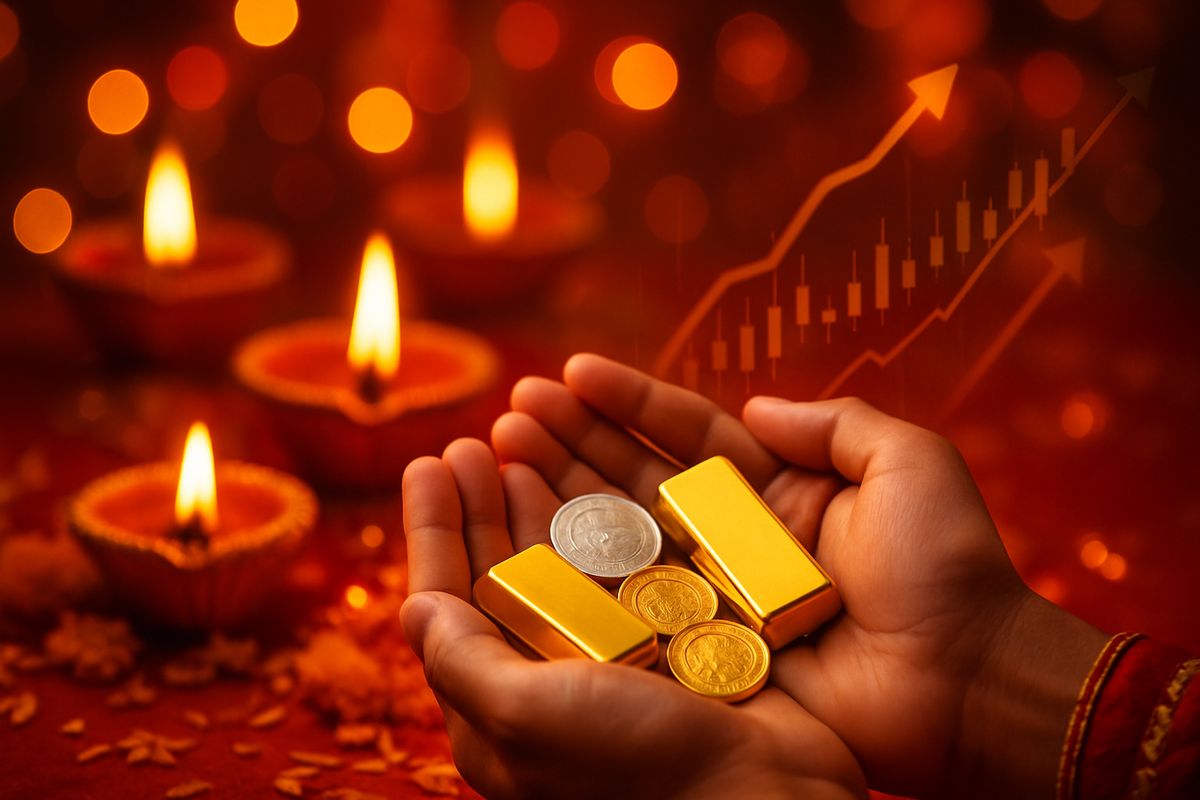
The Indian financial markets are currently witnessing an extraordinary rally in gold and silver prices, propelled by a potent combination of global economic anxieties and an anticipated surge in domestic festive demand. With Dhanteras 2025 just around the corner, scheduled for October 18, 2025, the deeply ingrained cultural tradition of purchasing precious metals is driving prices to record-breaking levels, creating a unique dynamic where consumer enthusiasm appears to defy conventional price sensitivity. This phenomenon is not merely a local event; India's insatiable appetite for gold and silver during this auspicious period is sending significant ripple effects across global commodity markets.
The Golden Tide: Dhanteras 2025 Ignites a Historic Rally
The current ascent of gold and silver prices is nothing short of historic. As of mid-October 2025, 24-carat gold in India is hovering around ₹13,277 per gram, with the Multi Commodity Exchange (MCX) showing gold near ₹1,27,000 per 10 grams and projections hinting at a potential breach of ₹1,30,000. Globally, spot gold prices have already surged past US$4,300 per ounce, marking an astounding 58% year-to-date increase and surpassing the US$4,000 per ounce threshold at the beginning of the month. Silver has followed suit, trading around ₹188.90 per gram or ₹1,88,900 per kilogram in India, and internationally breaking its 1980 record by surpassing US$52 per ounce in mid-October, an almost 80% jump since January 2025.
This unprecedented rally is fueled by a perfect storm of factors. On the global stage, persistent geopolitical tensions, stubborn inflation concerns, the anticipation of US interest rate cuts, and robust central bank gold acquisitions are providing significant tailwinds. Domestically, the unique cultural significance of Dhanteras, coupled with strong demand from other Asian markets and growing industrial demand for silver (especially in solar and electric vehicle sectors), are acting as powerful catalysts.
The timeline leading up to Dhanteras 2025 has seen a steady build-up of bullish sentiment. Since early 2025, analysts have pointed to escalating global uncertainties as a key driver for safe-haven assets. As the festive season approached in Q3 and Q4 2025, domestic demand forecasts began to solidify, further pushing prices. Key players include millions of Indian consumers who view these purchases as both an auspicious ritual and a sound investment, as well as jewelers and bullion dealers who are scrambling to meet the demand. Initial market reactions have been characterized by a noticeable shift among consumers towards buying gold and silver coins and bars over traditional jewelry, indicating a stronger investment-driven mindset. Reports of bullion shortages, particularly for gold coins, underscore the intensity of the current demand.
Corporate Fortunes in Flux: Navigating the Precious Metal Surge
The unprecedented rally in gold and silver prices presents a complex landscape for public companies operating in India's vast jewelry and precious metals sector. While the festive demand offers a robust sales opportunity, the soaring prices are forcing a strategic re-evaluation across sales, inventory management, and overall business models.
Leading the charge among the potential winners are large, organized jewelers such as Titan Company Ltd (NSE: TITAN), which owns the prominent Tanishq brand, Kalyan Jewellers India Ltd (NSE: KALYANJEWEL), and Senco Gold Ltd (NSE: SENCO). These established players benefit from strong brand trust, sophisticated inventory management systems, and robust hedging capabilities that allow them to mitigate price volatility. Their financial strength also enables them to offer flexible payment schemes and aggressively expand their retail footprint, capturing market share from the less organized sector. Despite a potential dip in the sheer volume of gold jewelry sales, the higher prices are expected to maintain or even boost value-based sales for these organized retailers. Furthermore, their ability to diversify product offerings – focusing on lighter-weight designs, diamond-studded jewelry, and alternative metals like silver and platinum – allows them to cater to a broader spectrum of consumer budgets. For instance, Titan Company (NSE: TITAN) has been exploring international manufacturing and leveraging trade agreements like CEPA with the UAE to expand its global reach, further insulating it from purely domestic fluctuations.
Conversely, smaller, unorganized jewelers are likely to be the primary losers in this high-price environment. They often lack the financial muscle for effective inventory hedging, have limited access to credit, and struggle to offer competitive pricing or diverse product ranges. The liquidity crunch caused by expensive gold can make inventory replenishment a significant challenge, potentially leading to a slump in business and impacting the livelihoods of numerous artisans dependent on their orders. Companies heavily reliant on traditional, heavy 22K/24K gold jewelry, without a strategic pivot to lighter designs or alternative metals, also face substantial volume declines. Even some established names, like PC Jeweller (NSE: PCJEWELLER), continues to grapple with regaining investor trust, which can exacerbate challenges in a volatile market.
The rally has also spurred a noticeable shift in consumer behavior. Many buyers are now opting for gold and silver coins and bars for investment purposes, recognizing them as a store of value and anticipating further price increases. This benefits dedicated bullion dealers and digital gold platforms. Jewelers are adapting by promoting lighter-weight designs, lower karatage gold (18-karat and even 9-karat), and increasing their focus on studded and diamond jewelry where artistry and gemstone value can offset the gold's weight. Silver, often dubbed "poor man's gold," has seen a significant spike in demand due to its relative affordability and impressive returns (over 70% rally in 2025), though a severe physical silver shortage in India has led to high premiums and challenges for jewelers in replenishing stock. Companies like Rajesh Exports Ltd (NSE: RAJESHEXPO), a major global gold refiner and manufacturer, may see increased demand for their bullion products, while their retail arm will need to adapt to changing consumer preferences.
Overall, the current scenario underscores the resilience and adaptability of the organized Indian jewelry sector. While high prices present challenges, strategic shifts towards product diversification, innovative financial schemes like EMI options and advance booking, and aggressive market expansion are positioning these larger players to capitalize on the enduring cultural and investment appeal of precious metals, even as the market experiences unprecedented price levels.
Broader Horizons: A Confluence of Trends and Global Ramifications
The current gold and silver rally, while acutely felt in the Indian market due to Dhanteras 2025, is deeply embedded within a broader tapestry of global economic and geopolitical trends. This surge in precious metal prices transcends mere seasonal demand, acting as a potent indicator of shifting paradigms and carrying significant ramifications for international markets and policy.
At its core, the rally underscores the enduring role of gold and silver as quintessential inflation hedges and safe-haven assets. Persistent inflationary pressures across major economies, coupled with a backdrop of geopolitical instability—including ongoing conflicts, trade disputes, and economic uncertainties in the US—are driving investors towards these tangible stores of value. A weakening US dollar further enhances the appeal of dollar-denominated commodities to international buyers. For India, the cultural significance of gold and silver extends beyond mere investment; it's a deeply spiritual and traditional act, particularly during festivals like Diwali and the wedding season. This ingrained cultural affinity translates into robust physical demand that can sustain prices even at unprecedented levels, making India a critical influencer in global gold dynamics.
Beyond cultural demand, silver's rally is uniquely bolstered by significant industrial demand. It is an indispensable component in rapidly expanding sectors such as renewable energy (solar panels), electronics, 5G technology, and electric vehicles. This structural industrial demand, coupled with global supply constraints, has been a major factor in silver's outperformance. Furthermore, central banks, particularly from BRICS nations, have been aggressively accumulating gold to diversify reserves away from a weakening US dollar, a trend that echoes historical periods of economic and geopolitical flux. Substantial inflows into gold and silver Exchange-Traded Funds (ETFs) also highlight a "fear of missing out" (FOMO) phenomenon among retail investors and funds, further propelling prices.
The ripple effects of this rally are extensive. Gold and silver mining companies globally, such as Newmont Corporation (NYSE: NEM) and Barrick Gold Corporation (NYSE: GOLD), are poised for windfall profits and improved margins, potentially leading to increased exploration and production. Conversely, the strong performance of precious metals could divert capital from traditional assets like bonds and even equities. For major gold-consuming nations like India, elevated gold and silver imports can widen current account deficits and strain foreign exchange reserves, potentially impacting the local currency.
Regulatory and policy implications are also at play. High import duties and Goods and Services Tax (GST) in India contribute to a domestic price premium, potentially encouraging informal trade. Easing these duties could channel transactions through legal avenues. Central bank monetary policies, particularly the anticipation of US interest rate cuts, make non-yielding assets like bullion more attractive. The absence of central bank intervention in silver markets, unlike gold, makes it more volatile but also more responsive to pure supply-demand dynamics. The increasing industrial demand for silver might also lead to greater government involvement in strategic mineral stockpiling.
Historically, the current rally shares similarities with past crises, such as the oil shocks of the 1970s or the 2008 financial crisis, where gold acted as a safe haven. Silver's surge, which has exceeded its 1980 peak and mirrors the 2010-11 spike, is distinct in that it is significantly driven by both its monetary hedge status and its critical industrial necessity, alongside multi-year supply shortages. This suggests a potential revaluation of silver, narrowing its historical gold-to-silver ratio. The ongoing rally is thus a multifaceted phenomenon, reflecting not just seasonal demand but also profound global anxieties, shifting economic paradigms, and the enduring, multifaceted significance of precious metals.
What Comes Next: Navigating the Precious Metal Path Forward
The period following Dhanteras 2025 is poised to be a critical juncture for gold and silver markets, with a predominantly bullish long-term outlook despite potential short-term volatility. The underlying drivers of the current rally—global economic uncertainties, persistent inflation, dovish central bank policies, and robust demand—appear strong enough to sustain an upward trajectory for both precious metals well into 2026 and beyond.
In the short term (Q4 2025 - Q1 2026), while some profit-taking might lead to minor corrections after the intense festive buying, the overall bullish momentum is expected to persist. Analysts at ANZ Group Holdings Ltd. project gold to reach US$4,400 per ounce by year-end 2025 and potentially peak near US$4,600 by mid-2026. JPMorgan Chase & Co. echoes this sentiment, forecasting gold to average US$3,675/oz by Q4 2025 and surpass US$4,000/oz by Q2 2026. Silver, known for its higher volatility, is anticipated to consolidate around US$50-US$55 per ounce, with some aggressive forecasts seeing it hit US$70 per ounce by the end of 2025. Short-term corrections of 10-20% for silver are considered possible, but likely within a broader uptrend.
Looking further ahead (2026 and beyond), the long-term outlook for gold remains robust. Goldman Sachs projects gold at US$4,900 per ounce by year-end 2026, while Bank of America targets US$5,000 per ounce for the same period. Some aggressive predictions even suggest gold could reach US$6,000 per ounce under specific conditions, and significantly higher by the end of the decade. Silver is expected to potentially outperform gold in the long run, driven by its dual role as a monetary asset and an increasingly critical industrial metal. HSBC forecasts silver to challenge its historical benchmark of US$50/oz in 2025-2026, with some analysts like Motilal Oswal and Bank of America projecting it to reach US$75 or US$65 per ounce respectively by 2026, and even higher in subsequent years.
Strategic pivots for companies will be crucial. Gold and silver mining companies will likely leverage robust cash flows to increase exploration budgets, reduce debt, and optimize existing operations. They may also pursue strategic mergers and acquisitions and adopt advanced technologies to enhance efficiency. For jewelry and investment firms, diversification will be key. Financial institutions will continue to advise increased allocations to physical bullion, precious metal ETFs, and mining company ETFs. Jewelry retailers will need to maintain their focus on product innovation—offering lighter designs, alternative metals, and flexible payment schemes—to adapt to evolving consumer preferences and price sensitivities.
Market opportunities abound in the sustained investment demand, particularly from individuals, institutional investors, and ETFs. The burgeoning industrial demand for silver in green energy and electronics presents a significant and growing market. Both metals will continue to serve as compelling hedges against inflation and safe havens during geopolitical uncertainties. Challenges include potential increased volatility and short-term corrections, a more hawkish turn by central banks, unexpected dollar strength, or a swift resolution of global conflicts. However, the structural nature of current market drivers suggests limited downside risk.
Various scenarios could unfold: the most likely is a continued bull market, driven by persistent inflation, dovish central bank policies, and strong demand. We might also see periods of consolidation and healthy corrections, which would be viewed as buying opportunities. A less likely but possible scenario is a significant bearish correction if global tensions abate swiftly or central banks unexpectedly tighten monetary policy. However, the prevailing sentiment points towards a sustained upward trajectory, making precious metals a key asset class to watch.
Comprehensive Wrap-up: A New Era for Precious Metals
The gold and silver rally, significantly amplified by India's robust festive demand for Dhanteras 2025, marks a pivotal moment in financial markets. This event is far more than a seasonal blip; it reflects a powerful convergence of enduring cultural traditions, profound global economic shifts, and escalating geopolitical uncertainties. The unprecedented price levels, while challenging for some consumers and smaller businesses, underscore the metals' reinforced status as indispensable assets in an increasingly volatile world.
Key takeaways from this rally include the undeniable strength of gold and silver as inflation hedges and safe havens, the unique and powerful influence of Indian cultural demand on global prices, and silver's emerging dual role as both a monetary metal and a critical industrial commodity. The organized jewelry sector in India has demonstrated remarkable adaptability, pivoting to lighter designs, alternative metals, and innovative financial schemes to navigate the high-price environment. Mining companies are poised for significant gains, while investors are increasingly diversifying into precious metals to protect wealth.
Moving forward, the market is expected to remain bullish, albeit with intermittent periods of volatility. The Federal Reserve's stance on interest rates, the trajectory of global inflation, and the resolution (or escalation) of geopolitical tensions will be crucial determinants of price movements. Central bank buying, particularly from non-Western nations, will continue to provide a strong floor for gold prices, while silver's structural supply deficits and surging industrial demand will likely propel its value.
Investors should watch for sustained central bank gold purchases, further clarity on global inflation trends, and any shifts in major central bank monetary policies. The performance of the US dollar will also be a key indicator, as its weakening typically boosts dollar-denominated commodities. For those in the jewelry sector, continued innovation in product offerings, efficient inventory management, and strategic hedging will be paramount. The current rally is not just about a temporary price spike; it signals a new era where precious metals are reasserting their fundamental value in the global financial architecture, making them a compelling watch in the coming months and years.
This content is intended for informational purposes only and is not financial advice





